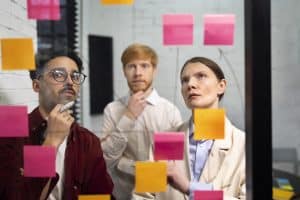In 2025, the organized thought stress reduction trend is rising fast as people seek practical, scientifically backed ways to calm racing minds—and this article shows how mind mapping, brain flossing, sensehacking, and digital wellness tools can help. These proven techniques not only reduce stress but also enhance clarity, focus, and emotional resilience, empowering individuals to take full control of their mental health journey.

Why Organized Thought Matters for Stress Relief
Overthinking, scattered attention, and mental clutter fuel anxiety and burnout. Organizing thoughts into meaningful structures—not by suppression, but by clarity—enhances focus, eases rumination, and uplifts well-being. The organized thought stress reduction approach empowers cognitive control and life balance.
Mind Mapping: Visual Brain Organization
Mind mapping is a visual method to structure ideas and reduce mental overwhelm—ideal for journaling, planning, and processing emotions.
-
Studies show mind maps improve recall by 10–15 % and reduce anxiety in learners (Feng et al. 2023; The Digital Project Manager 2025).
-
Mind maps help connect concepts into a cohesive hierarchy, improving problem-solving and clarity (The Decision Lab 2025).
Quick how-to:
-
Place your main issue (e.g. “Work stress”) at center
-
Create branches: triggers, reactions, solutions
-
Use keywords, colors, icons
-
Navigate the map to spot patterns and prioritize solutions
Mind mapping functions as organized thought turned into visual clarity.
Brain Flossing: Resetting with 8D Audio
A rising mental wellness trend in 2025 is brain flossing—immersive 8D audio experiences that simulate sound moving around the head, helping “clear mental clutter” in minutes.
-
Users report reduced racing thoughts, improved relaxation, better sleep, and heightened focus.
-
It acts like a cognitive reset button, activating both hemispheres, easing stress quickly (NY Post 2025).
Pair this auditory process with a reflective thought‑map afterward: note lingering thoughts, patterns, or revelations. This bridges immersive relaxation and organized self‑reflection.
Sensehacking: Organizing Your Environment for Calm
The new wellness buzzword is sensehacking—crafting sensory spaces intentionally so your mind feels safe, calm, and ordered.
Examples:
-
Morning exposure to natural light to regulate mood and circadian rhythm
-
Curated sounds (ambient playlists or tones) to reduce chaos
-
Familiar, comforting scents linked to focus and calm
-
Mindful eating practices: noticing textures, smells, tastes
Sensehacking aligns your sensory environment with your mental clarity, reducing overstimulation and helping organized thinking flow (Daily Telegraph 2025).
Digital Mental Fitness & Real-Time Stress Tools
Leading wellness platforms in 2025 emphasize cognitive wellness via technology:
-
Corporate cognitive wellness programs promote brain-training, focus blocks, and proactive stress prevention (Global Wellness Institute 2025).
-
Wearables and apps are now integrated with AI to detect stress leaks in real time and prompt thought‑organizing actions like breathing or journaling breaks (Arxiv 2025).
Idea: Use devices that alert you when your stress patterns rise, then pause and reconstruct racing thoughts via simple mind map or sensory reset.
VR-Assisted Attention Training & Nature Immersion
A growing research trend supports virtual environments as tools for stress management:
-
VR-based attention training has shown early success reducing EEG‑detected stress in experimental settings (Arxiv 2025a).
-
VR forest bathing—immersive high‑fidelity nature simulations—produces measurable improvements in executive functioning and stress relief (Arxiv 2024).
After a short VR session, organize reflections with a digital map or visual notes: What thoughts surfaced? What stress triggers appeared? How did attention feel before and after?
How to Integrate These Trends into an Organized Thought Routine
1. Morning Mapping
Spend 5–10 minutes mind mapping your mental load—tasks, worries, feelings. Label anxieties as branches you can revisit later.
2. Mid‑day Brain Floss Breaks
Use 8D or binaural audio for 5 minutes when you feel scattered. Then revisit that morning map: adjust branches, add new branches.
3. Sense‑Optimized Workspace
Design your space: natural light, calming scents, soft ambient music. Reset spaces so your mind subconsciously registers order and calm.
4. Digital Stress Alerts + Journal Prompts
Let wearables detect rises in heart rate variability. When triggered, launch a mindful mapping prompt: “What are my current worries or tasks?”
5. Weekly VR Reflection Session
Use at-home VR nature or attention-training tools. Afterward, free‑form map your emotional and thought responses for insight and prevention.
Why These Methods Work Together
These four methods—mind mapping, brain flossing, sensehacking, and tech‑supported reflection—serve organized thinking at different layers:
-
Mind maps structure your internal narrative
-
Brain flossing punctuates scattered thought with brief resets
-
Sensehacking aligns outer environment with inner order
-
Wearables and VR offer real-time alerting and immersive clarity
Together they form an ecosystem of organized thought stress reduction: building awareness, structuring thoughts, resetting clutter, and measuring patterns.
Benefits: What the Evidence Shows
-
Mind mapping improves recall, reduces cognitive anxiety, and increases creative solutions (Feng et al. 2023; The Decision Lab 2025).
-
Brain flossing, though newer, has multiple user reports of immediate mental clarity and stress reduction (NY Post 2025).
-
Sensehacking draws on environmental psychology findings: sensory design improves mood and mental focus (Daily Telegraph 2025).
-
Digital mental fitness tools show statistically significant reductions in acute stress and improved self-awareness in trials (Arxiv 2025; Global Wellness Institute 2025).
Practical Tips to Get Started Today
-
Pick one: begin with mind mapping or brain flossing—don’t overwhelm yourself.
-
Use simple tools: free mind‑map apps, 8D audio tracks, timer for break prompts.
-
Track progress: note changes in focus, stress levels, or clarity over days.
-
Iterate and personalize: choose the mix that resonates for your schedule and space.
-
Stay consistent: short daily routines build cumulative benefits.
Final Thoughts
In a world overflowing with info and distraction, stress often stems from chaotic, unstructured thinking. The emerging organized thought stress reduction trend offers practical, science-backed tools—from visual mapping to immersive resets to sensory design—that transform mental overwhelm into structured clarity.
By combining mind mapping, brain flossing, sensehacking, and digital feedback loops, you build a personal ecosystem of thought organization and cognitive calm. In 2025’s wellness landscape, these tools reflect the shift from reactive coping toward structured, preventive mental wellness. With daily use, these strategies transform mental chaos into manageable patterns, promoting better mental hygiene and sustained emotional balance—essential tools in today’s overstimulated world.
References
-
The Digital Project Manager (2025) ‘Benefits of Mind Mapping for Productivity’. Available at: https://thedigitalprojectmanager.com (Accessed: 4 August 2025).
-
NY Post (2025) ‘Brain Flossing: How 8D Audio May Help Mental Clarity’. Available at: https://nypost.com (Accessed: 4 August 2025).
-
Daily Telegraph (2025) ‘What is Sensehacking and Why is It Taking Over Wellness?’. Available at: https://www.dailytelegraph.com.au (Accessed: 4 August 2025).









